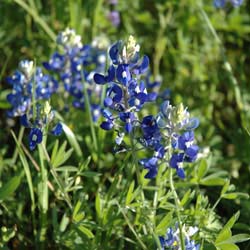Salvias Down South: Tough Texans Sing the Blues

Blue, in all its many shades, brings peace to a flower garden. It is a soothing, cool color that sings of sky and ocean in all their many shades. It is especially eye-catching when it is an elusive, rich true-blue like that of West Texas Grass Sage (Salvia reptans).
Texas Bluebonnets (Lupinus texensis) are legendary for their carpets of royal blue that spread across highway verges in Spring. Other tough Texans that are gaining attention include a number of blue Salvias. But where does all that blue come from?
Flower Petal Chemistry
The same anthocyanins that make berries such a healthy dietary choice also give them their colors. Similarly these chemicals, which are part of the sugar-containing flavonoid group, create the wide variety of blues, purples and reds in the petals of flowers such as Salvias.
To some degree soil pH can affect the hue of flower petals. For example, a flower leaning toward red may become more blue as soil pH moves from a high acidity toward what is referred to as a sweet or alkaline soil containing higher levels of lime.
Luckily, plant developers have found ways to create reliable blue colors in many cultivated wildflowers when they are grown in certain pH ranges. But this is where we drop all the chemistry mumbo jumbo, except to say that we are thankful for anthocyanins and plant breeders.
Tough Blue Texans at FBTS
Our main point is that we can help you create a soulful garden bursting with reliably blue Salvias that are drought-resistant, long-blooming Texas natives. All grow happily in USDA plant hardiness zones 8 to 9, with some growing in areas as cool as Zone 4 and as hot as Zone 11.
The colors range from shades of sky blue on a sunny day – sometimes called cerulean blues – to lavenders and purples. Some are subtly bicolored with touches of white at their throats.
In addition to Texas, some of these Southwestern sages are native to other states, such as Big Pitcher Sage (Salvia pitcheri grandiflora), which is native to states from Nebraska to Colorado and from Texas to Kentucky. Also known as Blue Sage or Prairie Sage, it is confused sometimes with the smaller-blossomed S. azurea, which is also called Prairie Sage and may be a close relative.
Here are the FBTS Texas blues, organized cerulean “true” blues to shades of purple. All prefer well-drained soil. Some like it rich; others are satisfied with poorer fare.
Prairie Sage (S. azurea). Also known as Azure Blue Sage, this wildflower is native to or long established in many states from Utah moving eastward to the Atlantic. Its intense cerulean flowers have a long, lower lip tinged with white at the throat. They blossom from Summer through Fall. S. azurea needs full sun and appreciates a richer soil than many sages. It grows from 24 to 36 inches tall and 18 inches wide.
Big Pitcher Sage (S. pitcheri grandiflora). Some sources say Big Pitcher is a variety of Prairie Sage, because its vertical form and flowers are so similar. However, Big Pitcher grows up to 60 inches tall and 24 inches wide. Its blooms are also are much bigger.
S. pitcher grandiflora grows in a broader temperature range (Zones 4 to 9) than S. azurea, which does well in Zones 7 to 9. Another major difference between the two is Big Pitcher’s tolerance of partial shade.
West Texas Grass Sage (S. reptans). As its name indicates, this sage looks a bit like an ornamental grass with tiny leaves and sky-blue flowers that bloom from late Summer through Autumn. It grows in dense clumps up to 48 inches tall and 24 inches wide. Although West Texas Grass Sage prefers full sun, it tolerates afternoon shade and grows well in Zones 5 to 9. Rich soil is best.
Purple Stem Sage (S. x ‘Purple Stem’). Although the darkly dramatic stems of this sage are purple, its flowers are a bluish lavender. Purple Stem Sage does well in heat with limited water, but its soil should drain well for those occasional downpours. It grows up to 60 inches tall and 36 inches wide in Zones 8 to 9. California native sages enjoy its company.
Arizona Blue Sage (S. arizonica). Yes, it’s name says blue, but this is another species with intense lavender blossoms. Arizona Blue Sage is an excellent mounding groundcover growing up to 24 inches tall and wide. It has bright green, lance-shaped leaves and does well in Zones 6 to 11 in full sun to partial shade. This is another sage that prefers rich soil.
Rock Sage (S. pinguifolia). Finally, this rare, tenacious sage is a tough one living in the dry limestone walls of canyons in Arizona, New Mexico and West Texas. It reaches 48 inches tall and wide, and has deep green, scalloped leaves that contain viscous, aromatic resins helping it survive drought.
Questions?
Please send us an email or call if you have any questions about how to cool down or warm up the look of your Salvia gardens. We always listen and do our best to help, even when you sing the blues.

 Salvia arizonica
Salvia arizonica  Salvia x 'Purple Stem'
Salvia x 'Purple Stem'  Salvia reptans
Salvia reptans  Salvia pitcheri grandiflora
Salvia pitcheri grandiflora  Salvia azurea
Salvia azurea
Comments
There are no comments yet.